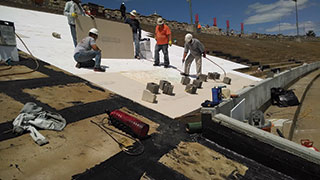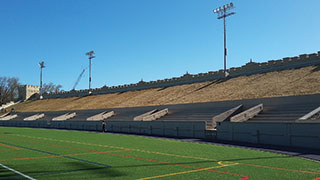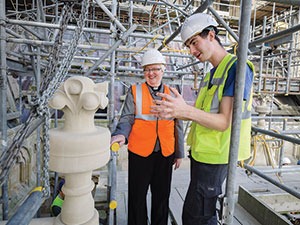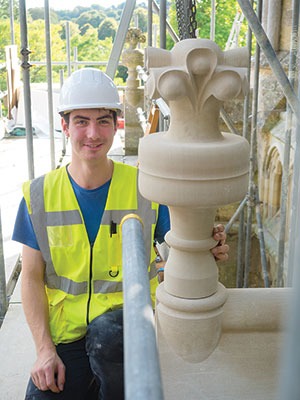REHABS AND RESTORATIONS
Lightweight and environmentally friendly, Geofoam solves unique design and construction challenges on the K-State Memorial Stadium renovation.
By John Myers
Founded in 1863, Kansas State University in Manhattan, Kan., was the first public institution of higher learning in the state. The campus’ architectural style is well defined by the use of native Cottonwood Limestone in stout masonry buildings featuring arch-capped entrances and windows. Memorial Stadium was constructed as a tribute to Kansas State students killed in World War I, and is composed of two independent halves: west stadium (completed in 1922) and east stadium (completed in 1924). The general seating capacity was 17,500, and the stadium faithfully served as home to the Wildcats’ football team until 1967, when the University opened a newer facility.
In the nearly 50 years since, Memorial Stadium has remained a fixture of K-State campus life without having a defined function. The fields have served campus activities like band practices, intramurals and jogging, while the functions of the interior buildings beneath the stands have included academic, administrative and storage. Most recently, the east stadium building housed KSU’s Telecommunications Department and the Purple Masque Theater, while the west stadium primarily provided creative space to students in the Graduate Studies in Arts Department.
 In a multi-phase process that reached completion in April 2016, the university undertook a program to revitalize and repurpose Memorial Stadium. With the first phase of construction breaking ground in November 2013, this two-and-a-half-year process included a complete masonry rehabilitation and repositioning each of the wings as new campus amenities.
In a multi-phase process that reached completion in April 2016, the university undertook a program to revitalize and repurpose Memorial Stadium. With the first phase of construction breaking ground in November 2013, this two-and-a-half-year process included a complete masonry rehabilitation and repositioning each of the wings as new campus amenities.
“Being a part of the preservation of this important community touchstone is what makes being a mason feel special,” remarks Shawn Smoke, assistant vice president at Restoration and Water Proofing, the masonry contractor responsible for the stonework rehabilitation on Memorial Stadium. Restoration and Water Proofing is a 42-year-old business with offices in Wichita, Topeka and Kansas City, where Smoke is the branch manager. He oversees masonry and waterproofing teams working on a wide range of projects, but believes historic masonry is an exceptional challenge and thrill. His role in the K-State project stretches back to 2014, when he began working with the university to develop a masonry rehabilitation budget and scope of work that were ultimately used in the contract documents. While the thrill comes largely from completing the project, one of Smoke’s biggest challenges was finding replacement materials for stones taken from the ground close to a century ago.
 “Trying to source stone as close to a replica as possible is always a goal in preservation work,” says Smoke, who gladly shares credit with stone supplier Lardner for finding the best match on Memorial Stadium. Together, they closely scrutinized the stone being removed from Memorial Stadium in order to find a near-replica in Lardner’s quarry.
“Trying to source stone as close to a replica as possible is always a goal in preservation work,” says Smoke, who gladly shares credit with stone supplier Lardner for finding the best match on Memorial Stadium. Together, they closely scrutinized the stone being removed from Memorial Stadium in order to find a near-replica in Lardner’s quarry.
“Lardner was able to cut every stone to the exact dimensions needed and sent them out to the site ready to be placed,” continues Smoke, who estimates that his team replaced approximately 20 percent of the existing stones in both stadium wings. They were also charged with removing and completely rebuilding the parapet walls ringing both structures.
“The way the parapets were originally built didn’t really consider the need for water to escape from the stone properly. We needed to modernize that and decided to build a composite wall system to increase longevity and effectiveness.” The new parapets are built from a CMU core encased in the new replica stone. The result is a near-perfect match to the original structure in appearance, yet more structurally sound.
Beyond the masonry restoration, the project involved a complete gut and renovation of both wing buildings below the stands. The west wing now serves as a campus theater, and the east wing is a new location for student services, financial aid, housing and dining services, and the career center. One unusual challenge in the project was how to rehabilitate the concrete risers above the revitalized structures. Since the stands had always served as roofs to the buildings underneath, that function had to remain, though they no longer needed to account for 17,500 screaming Wildcats fans. K-State’s landscape architecture department proposed transforming the majority of the seating into green roofs. Planted with native materials, the green roof provides an ideal way to reseal the structures, while enhancing the stadium aesthetically and making a strong environmental statement.
 Because current building codes wouldn’t allow a tremendous amount of weight to be added to the roofs, designers turned to ACH Foam Technologies’ Foam-Control EPS Geofoam, an innovative commercial building product that is about 1 percent of the weight of natural soil. ACH’s specially engineered expanded polystyrene (EPS) foam offered a lightweight material capable of filling in the slopes created by the rows of seating without overburdening the structural capacity of the roofs. The contoured slab was then covered with a thin layer of soil and planted with native species in a K-State color palette, creating a sloped prairie hillside bisected by a running track.
Because current building codes wouldn’t allow a tremendous amount of weight to be added to the roofs, designers turned to ACH Foam Technologies’ Foam-Control EPS Geofoam, an innovative commercial building product that is about 1 percent of the weight of natural soil. ACH’s specially engineered expanded polystyrene (EPS) foam offered a lightweight material capable of filling in the slopes created by the rows of seating without overburdening the structural capacity of the roofs. The contoured slab was then covered with a thin layer of soil and planted with native species in a K-State color palette, creating a sloped prairie hillside bisected by a running track.
“Figuring out the contours of all the steps was really quite a puzzle,” says Curtis Calvert, project manager for Hutton Construction, who is a K-State alumnus. Calvert credits roofing subcontractor Western Specialty Group for determining the most efficient way to cover the slope without much material or labor waste. “They came out and mapped every inch of the stadium, which allowed each piece of foam to be specially cut and configured for placement on the slope.”
Smoke and Calvert both shared a story for the ages about the project. “As we were doing the punch list, walking along the east stadium’s exterior wall, a few individual stones were identified that we wanted to replace,” recalls Smoke. Behind one of those stones among literally thousands, a foreman discovered an old tin can with a note inside. “The note was handwritten and signed by five masons who had worked on the original construction,” continues Smoke. Such an incredible find should remind us all that buildings are built by real people with a commitment to their craft.
John Myers, ACH Foam Technologies, can be reached at jmyers@achfoam.com.
In the NewsCathedral Apprentice Leaves His Mark |
 Salisbury Cathedral is one of Britain’s finest medieval cathedrals. More than 300,000 people visit the cathedral each year to marvel at the nearly 800-year-old building and admire Britain’s tallest spire. The finest original copy of the 1215 Magna Carta is on permanent display to visitors in the Chapter House of the cathedral. Salisbury Cathedral is one of Britain’s finest medieval cathedrals. More than 300,000 people visit the cathedral each year to marvel at the nearly 800-year-old building and admire Britain’s tallest spire. The finest original copy of the 1215 Magna Carta is on permanent display to visitors in the Chapter House of the cathedral.
The cathedral’s Major Repair Programme (MRP) began nearly 30 years ago. Comprehensive fabric repairs were needed. Many of the roofs were old, cracked in some places and distorted by thermal movement; the glazing, some of the finest in the country, was becoming frail and in need of re-leading, cleaning and isothermal glazing; and many of the stones in the walls were blistering, soot encrusted and eroded.
Salisbury Cathedral is one of only nine English cathedrals to have its own Works Department, which includes a team of stonemasons, glaziers, a dedicated ecclesiastical carpenter and a lead plumber. The department takes on one apprentice every four years, a much sought-after training post in which the trainee learns traditional stonemasonry skills. On Thursday, Sept. 22, 2016, cathedral stonemason Christian Sullivan marked the end of a four-year-long apprenticeship at a “topping off” ceremony held high on the scaffolding above the cathedral’s southeast side. Sullivan, who has now embarked on a Foundation degree in stonemasonry, spent the last two months of his apprenticeship carefully carving a copy of the damaged finial for the southeast side of the cathedral. Generally, only one major carving like this is done a year. Sullivan’s finial was the last stone to be laid, marking the end of that particular stage in Salisbury Cathedral’s 30-year-long MRP. The original finial was damaged as a result of Victorian restoration in which the masons used an iron pin to fix the finial to the stone below. The iron rusted and expanded, causing the stone to split. Today, cathedral masons use stainless steel pins, which do not rust. Sullivan said, “I knew I wanted to make things but never saw myself as a mason in particular. That is something that has grown with the job. It is amazing to think that my work is now up there on the east side and will be for the next few hundred years.” Also present at the “topping off” ceremony were 40 donors who participated in the Sponsor a Stone project. Donors have their initials carved into their stone, and it is fixed into the cathedral wall. They also receive a diagram that shows the position of their stone and can spend time in the Works Yard, visiting the mason who is creating it. Work is now beginning on the Trinity Chapel, on the east face, the oldest part of the cathedral. This has remained untouched since the foundations were laid in 1220. Now, frequent stone falls mean that it has to be roped off for restoration and its beautiful interior is being damaged by rain. For more information about the Sponsor a Stone project or the cathedral, contact Natalie Downing at n.downing@salcath.co.uk or Jilly Wright at j.wright@salcath.co.uk. |


